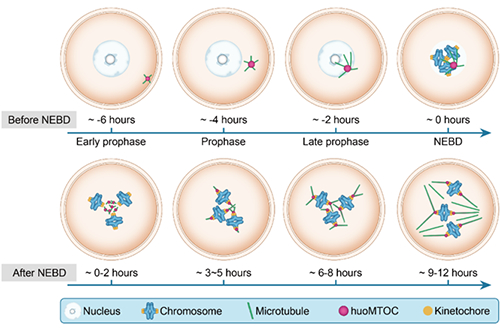
Figure. Meiotic spindle assembly in human oocyte
Supported by the National Natural Science Foundation of China (Grant No. 81725006, 82101737, 82171643, and 81971450), Prof. Lei Wang, Prof. Qing Sang, and Prof. Xiaoxi Sun’s research groups from Fudan University have made progress in the mechanism of spindle assembly in human oocyte. The research results were published in Science titled "The mechanism of acentrosomal spindle assembly in human oocytes".
Article link: http://www.science.org/doi/10.1126/science.abq7361.
Spindle assembly is the key event for mitosis and meiosis in mammals. Only the accurate assembly of the spindle can ensure the correct chromosome segregation in cell division and embryo development. The spindle assembly of human somatic cells is mediated by centrosomes, but centrosomes are absent in human oocytes, and the mechanism of spindle assembly in human oocytes has remained unclear.
This study found that the spindle microtubules are polymerized after the nuclear envelope breakdown (NEBD) and are mainly concentrated at the kinetochores of human oocytes. In addition, four microtubule related proteins (CCP110, CKAP5, DISC1, and TACC3) were detected in both kinetochores and microtubules in metaphase I (MI) human oocytes, which was notably different from their localization in mitotic cells. It was found that the four proteins formed a previously undiscovered special structure near the nuclear membrane in human geminal vesical (GV) oocytes and the aggregation of microtubules was observed around this structure which was not observed in mouse and porcine oocytes. It was termed as Human Oocyte Microtubule Organizing Center (huoMTOC), because this structure is responsible for the microtubule polymerization in human oocytes specifically. The huoMTOC is formed at the cortex of human oocytes and migrates to the nuclear membrane before NEBD. After NEBD, huoMTOC becomes fragmented and is recruited to kinetochores to initiate spindle microtubule polymerization (Figure). The microtubule polymerization and meiotic spindle assembly can be blocked by huoMTOC structure disruption. To further determine the clinical significance of huoMTOC, mutation screening in patients with oocyte maturation arrest revealed that two patients carried disease-causing compound heterozygous mutations in TACC3. The huoMTOC in the patients’ GV oocytes was completely destroyed and the spindle was not observed.
This study has discovered a novel submicroscopic structure termed huoMTOC in human oocytes and elucidated the unique physiological mechanism of huoMTOC in regulating meiotic spindle assembly. It also revealed that huoMTOC abnormalities lead to oocyte maturation arrest in patients, improving the understanding of the pathological mechanism of this disease.

Add: 83 Shuangqing Rd., Haidian District, Beijing, China
Postcode: 100085
Tel: 86-10-62327001
Fax: 86-10-62327004
E-mail: bic@donnasnhdiary.org
京ICP备05002826号 文保网安备1101080035号 Copyright 2017 NSFC, All Right Reserved